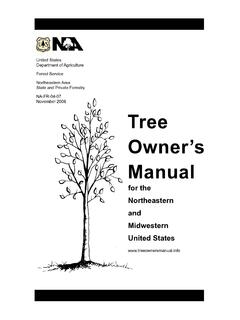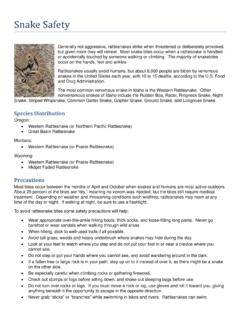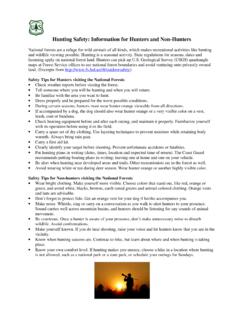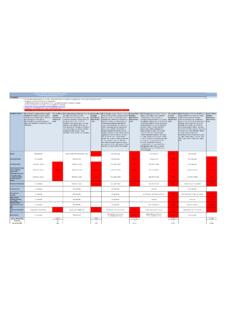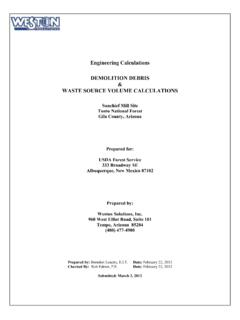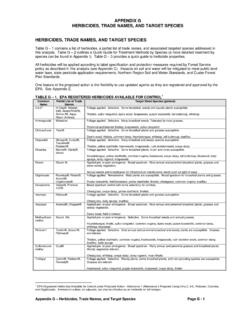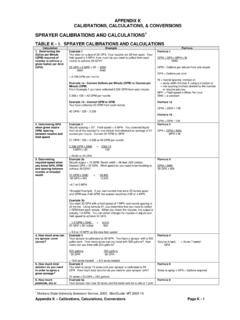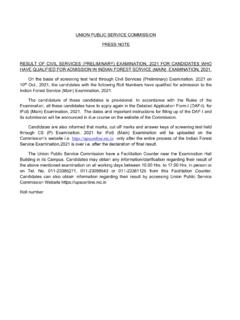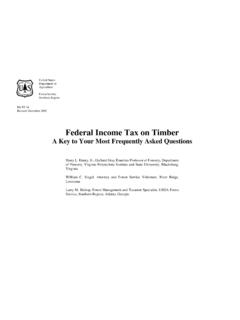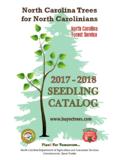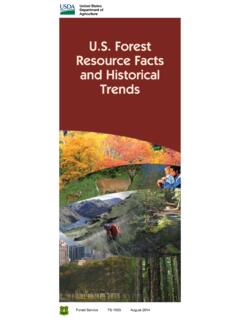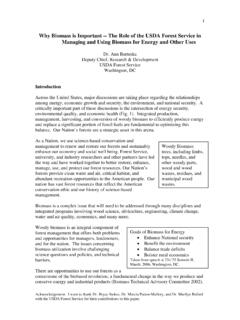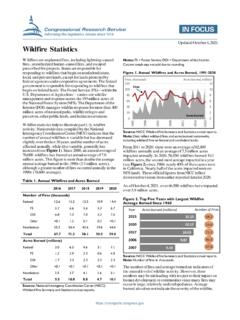Transcription of The Malheur National Forest - Home | US Forest Service
1 United States Department of Agriculture Forest Service Pacific Northwest Region The Malheur National Forest Location of the World s Largest Living Organism [The Humongous Fungus] Craig L. Schmitt, Forest Pathologist Michael L. Tatum, Forest Silviculturist 2008 Figure 1. Dead and live-symptomatic trees in this Armillaria root disease center. Down trees in the foreground died earlier. This root disease center is in Genet E. The Humongous Fungus on the Malheur National Forest Page 2 Figure 2. Vicinity maps showing the location of the Malheur National Forest and the Humongous Fungus on the Prairie City Ranger District.
2 A genetically unique individual organism". A group of at least five separate individual Armillaria ostoyae genets reside in the mountains east of Prairie City, Oregon (Fig. 3) in the Reynolds Creek and Clear Creek areas in the northeastern portion of the Malheur National Forest (a genet is a geneti-cally unique individual organism). Several of these genets are very large, including the largest known fungus genet in the world, identified with a red outline on the map (Fig. 3)as Genet D; the Humongous Fungus. Figure 3. Vicinity map of large Armillaria ostoyae genets, including the Humongous Fungus, on the Malheur National Forest , Oregon Page 3 Armillaria ostoyae, commonly known as the shoe-string fungus, parasitizes, colonizes, kills and decays the root systems of various conifer hosts, resulting in what Forest manag-ers know as Armillaria root disease.
3 While being a pathogen and tree-killer, Armillaria ostoyae can also maintain itself in dead woody material for many years as a saprophyte. Large root disease centers in the Reynolds Creek and Clear Creek areas were originally recognized by Malheur National Forest personnel. Site evaluations confirmed the preva-lence of Armillaria, and scientists were invited to conduct research associated with the fungus and their findings have confirmed the species, size, and estimated age of these individuals. Each Armillaria ostoyae genet shown in Figure 3 are separate networks of fungus myce-lia tested and determined to be genetically homogeneous, with each genet being a ge-netically different individual, occupying the soil and tree roots over areas that range in size from 50 to 2,385 acres (Table 1).
4 The largest individual, A. ostoyae identified in Fig 3 and Table 1 as Genet D, covers 2,385 acres, and is the largest known root disease center in the world. Using assumptions made for weight estimates of smaller Armillaria individuals discovered in Michigan by Smith and others (1992), biomass including fungal mycelia and rhizomorphs of Genet D, is estimated to weigh 7,567 to 35,000 tons, all in the soil and on the roots of diseased trees. So this Armillaria individual, located on the Malheur National Forest , is the largest (by biomass) known living organism (fungus, plant, or animal) in the world, and is known as the Humongous Fungus.
5 Table 1. Characteristics and locations of Armillaria ostoyae genets in the Reynolds Creek and Clear Creek areas, Malheur National Forest , Oregon (adapted from Ferguson and others 2003). These Armillaria genets are not only large, they are also very old, with Genet D estimated to be between 1900 and 8650 years, based on the current size of the genet and esti-mates of how long it took to expand to its current size at rates ranging from to feet a year. Page 4 Genet Width (feet) Area (acres) Age estimates (years)1 GPS coordinates Lat. / Long. DMS A 7,054 642 1100, 1250, 4900 44o 33 N 118o 28 W B 5,643 235 900, 1000, 4000 44o 30 N 118o 30 W C -- 50 -- 44o 28 N 118o 31 W D 12,500 2,385 1900, 2200, 8650 44o 28 N 118o 29 W E 6,660 482 1000, 1150, 4600 44o 27 N 118o 24 W 1 Using estimates of spread rates of ft/year (van der Kamp 1993), ft/year (Shaw and Roth 1976), and ft/year (Peet and others 1996).
6 While these Armillaria genets on the Malheur National Forest are huge in size and old in years, they are mostly hidden from sight. Mushrooms are produced for a short period of time in the fall season, usually following the first rains, and will appear at the base of live-infected or recently-killed trees (Figure 4). The Armillaria mushroom, commonly called the honey mushroom , is probably the most visible structure of the fungus seen by the casual observer. They are stalked, 2 to 4 inches tall, 2 to 5 inches across at the cap, and cream to tawny-brown in color. They do not persist for long.
7 Rhizomorphs are black, shoestring-like, branching structures of Armillaria and are character-ized as long, slender, and differentiated filamentous fungal tissues that grow in the soil. Rhi-zomorphs are commonly seen on the exterior of root systems of wind-thrown trees (Fig. 5) and sometimes under the bark. Rhizomorphs are characteristic of the different species of Armillaria and serve as a mechanism allowing the fungus to spread through soil. These rhizo-morphs find and infest new material, including live hosts. Rhizomorphs can be differentiated from similar-appearing roots by their white interior.
8 Page 5 Figure 4. Armillaria ostoyae mushrooms at the base of a live infected grand fir. Mushrooms are produced following the first rains in the fall of the year. They are commonly called the honey mushroom . Scientists are unsure of all the factors that allowed these genets to become as large and as old as they have. Armillaria may have effectively spread in historic forests of large trees that were less-densely stocked, and composed of species less susceptible to root disease. Alter-natively, Forest structure and composition are now possibly more amenable to Armillaria spread as current conditions are different from those that developed under the natural fire re-gimes of the last several hundred years (Ferguson and others - 2003).
9 The other fungal structures that may be seen are latex paint-like mats of mycelial felts that grow under the bark of live-infected trees (Fig. 6). These may be found for several years on infected trees after they have died (Fig. 7). Mycelial felts contribute to killing the host and will grow under the bark of the roots, root collar, and a short distance up the lower bole of trees. Mycelial felts growing under the bark usually result in resin extrusion through the bark and oozing down the bark surface at the root collar and lower bole. Mycelial felts may be found under the loose bark on the roots or root collar of recently windthrown trees.
10 Since standing dead trees may fail at any time, avoid walking or standing near, or disturbing standing dead trees. While the actual portions of the Armillaria fungus are largely hidden and often not always visi-ble, the symptoms expressed by diseased conifers ( dying trees, mortality and large dis-ease centers) are often striking and are the best way to appreciate the size and extent of Ar-millaria on the landscape. Since lateral spread of Armillaria occurs through the soil and across root contacts, the resulting expanding pattern in disease centers is a gradient of older dead, to recently-killed, to live-symptomatic, to non-symptomatic trees, moving from the mid-dle to the periphery of disease centers.

